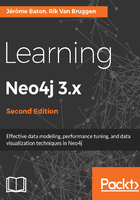
Web search
No book chapter treating graphs and graph theory--even at the highest level--will be complete without mentioning one of the most powerful and widely-used graph algorithms on the planet, PageRank. PageRank is the original graph algorithm, invented by Google founder Larry Page in 1996 at Stanford University, to provide better web search results. For those of us old enough to remember the early days of web searching (using tools such as Lycos, AltaVista, and so on), it provided a true revolution in the way the web was made accessible to end users.
The following diagram represents the PageRank graph:

The older tools did keyword matching on web pages, but Google revolutionized this by no longer focusing on keywords alone, but by doing link analysis on the hyperlinks between different web pages. PageRank, and many of the other algorithms that Google uses today, assumes that more important web pages, which should appear higher in your search results, will have more incoming links from other pages, and therefore, it is able to score these pages by analyzing the graph of links to the web page. History has shown us the importance of PageRank. Not only has Google, Inc. taken the advantage over Yahoo as the most popular search engine and built quite an empire on top of this graph algorithm, but its principles have also been applied to other fields, such as, cancer research and chemical reactions.
Now, we want to contextualize the concepts around graph databases and understand the historical and operational differences between older, different kinds of database management systems and our modern-day Neo4j installations.
To do this, we will cover the following:
- Some background information on databases in general
- A walk-through of the different approaches taken to manage and store data, from old-school navigational databases to NoSQL graph databases
- A short discussion explaining the graph database category, its strengths, and its weaknesses
This should set us up for some more practical discussions later in this book.